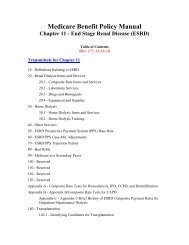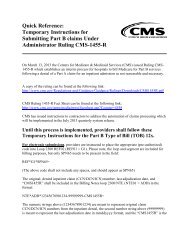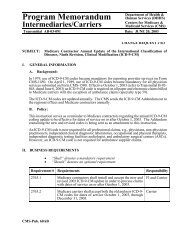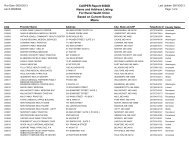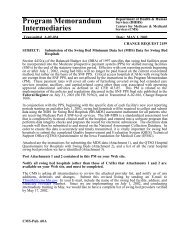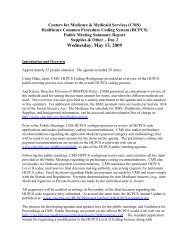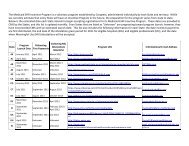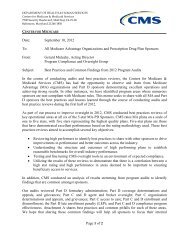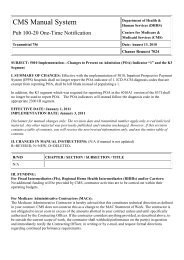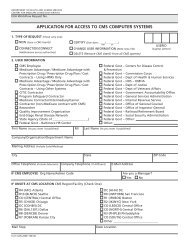CMS Change Management Policy [PDF, 106KB] - Centers for ...
CMS Change Management Policy [PDF, 106KB] - Centers for ...
CMS Change Management Policy [PDF, 106KB] - Centers for ...
Create successful ePaper yourself
Turn your PDF publications into a flip-book with our unique Google optimized e-Paper software.
<strong>Centers</strong> <strong>for</strong> Medicare & Medicaid Services<br />
Office of In<strong>for</strong>mation Services<br />
<strong>CMS</strong> <strong>Policy</strong> <strong>for</strong> <strong>Change</strong> <strong>Management</strong><br />
Version 1.0<br />
August 14, 2013
<strong>Centers</strong> <strong>for</strong> Medicare & Medicaid Services<br />
Record of <strong>Change</strong>s<br />
Version Date Author / Owner Description of <strong>Change</strong> CR #<br />
1.0 August 14, 2013 <strong>CMS</strong> Baseline policy N/A<br />
<strong>CMS</strong> <strong>Policy</strong> <strong>for</strong> <strong>Change</strong> <strong>Management</strong><br />
i<br />
Version 1.0 August 14, 2013
<strong>Centers</strong> <strong>for</strong> Medicare & Medicaid Services<br />
Table of Contents<br />
1. Introduction .................................................................................................................. 1<br />
1.1 Scope ................................................................................................................................1<br />
1.2 <strong>Change</strong> <strong>Management</strong> Overview .......................................................................................1<br />
2. Operational <strong>Policy</strong>........................................................................................................ 2<br />
2.1 Scaled Implementation .....................................................................................................2<br />
2.2 <strong>Change</strong> Control Boards ....................................................................................................2<br />
2.3 Communication of <strong>Change</strong>s .............................................................................................3<br />
3. Applicable Laws/Guidance ......................................................................................... 3<br />
4. Reference Documents .................................................................................................. 4<br />
5. Effective Dates/Implementation ................................................................................. 4<br />
6. Approval ....................................................................................................................... 4<br />
Appendix A. Glossary........................................................................................................ 5<br />
Appendix B. Acronyms ..................................................................................................... 7<br />
<strong>CMS</strong> <strong>Policy</strong> <strong>for</strong> <strong>Change</strong> <strong>Management</strong><br />
ii<br />
Version 1.0 August 14, 2013
<strong>Centers</strong> <strong>for</strong> Medicare & Medicaid Services<br />
1. Introduction<br />
The purpose of this policy is to ensure that any changes to <strong>Centers</strong> <strong>for</strong> Medicare & Medicaid<br />
Services (<strong>CMS</strong>) applications, systems, hardware, operating environments, and related<br />
specifications, user manuals, and maintenance manuals are managed through an established<br />
process. This policy establishes the guiding principles, direction, and expectations <strong>for</strong> planning<br />
and per<strong>for</strong>ming change management (CM) at <strong>CMS</strong>. This policy mandates that changes to all<br />
controlled in<strong>for</strong>mation technology (IT) products are made in accordance with this policy. The<br />
implementation of this policy is intended to mitigate the risks associated with unauthorized or<br />
uncoordinated changes to <strong>CMS</strong> assets.<br />
<strong>CMS</strong> expects that the implementation of this policy will be tailored or scaled to accommodate<br />
both large and small projects/systems in order to plan and apply the appropriate level of CM<br />
rigor that is necessary to protect <strong>CMS</strong> assets.<br />
1.1 Scope<br />
This CM policy applies to IT system changes and the business changes that impact IT assets.<br />
This document is a companion to the <strong>CMS</strong> <strong>Policy</strong> <strong>for</strong> Configuration <strong>Management</strong> and applies to<br />
all <strong>CMS</strong> IT environments (e.g., mainframe or client/server), all automated systems, software<br />
applications and products, supporting hardware and software infrastructure (e.g., equipment,<br />
networks, and operating systems), and associated documentation.<br />
This policy applies equally to all <strong>CMS</strong> operational IT systems as well as those under<br />
development. Typically, a change control board (CCB) manages systems under development,<br />
specifically established as part of the contract/project management <strong>for</strong> the project. There must<br />
also be a CCB in place <strong>for</strong> operational systems. The policy is applicable to the <strong>CMS</strong> centers and<br />
offices, all subordinate offices, projects, components, acquisitions, contracts, contractors,<br />
subcontractors, suppliers, as well as all agreements with partner/stakeholder organizations.<br />
1.2 <strong>Change</strong> <strong>Management</strong> Overview<br />
CM is the process that controls the lifecycle of all changes, enabling beneficial changes with<br />
minimal disruption to <strong>CMS</strong> business operations and IT services. The goals of the <strong>CMS</strong> <strong>Policy</strong> <strong>for</strong><br />
<strong>Change</strong> <strong>Management</strong> include the following:<br />
• Establish and en<strong>for</strong>ce a standard process <strong>for</strong> planning, approving, implementing, and<br />
communicating changes to all <strong>CMS</strong> applications, systems, hardware, and environments<br />
and related assets<br />
• Establish clearly defined best practice processes to ensure compliance with legal or<br />
regulatory requirements<br />
• Prevent or minimize risks that can occur as a result of unauthorized or uncoordinated<br />
changes<br />
<strong>CMS</strong> <strong>Policy</strong> <strong>for</strong> <strong>Change</strong> <strong>Management</strong> 1<br />
Version 1.0 August 14, 2013
<strong>Centers</strong> <strong>for</strong> Medicare & Medicaid Services<br />
The CM approach is scalable from a small project/system with few staff to large projects/systems<br />
with many staff, contractors, and stakeholders. <strong>CMS</strong> assets and changes to them can be<br />
appropriately controlled and managed by tailoring or scaling to the correct change management<br />
rigor <strong>for</strong> the specific application, project, or system.<br />
Projects and systems should use appropriately scaled <strong>for</strong>mal methods, including chartered CCBs,<br />
point of contact (POC) lists, and <strong>for</strong>mal processes and procedures, as described in this policy.<br />
2. Operational <strong>Policy</strong><br />
Each <strong>CMS</strong> project, application, system, operating environment, and related asset must institute<br />
systematic and measurable CM processes and procedures to ensure that proposed changes are<br />
properly identified, prioritized, documented, coordinated, reviewed, approved, rejected or<br />
deferred, communicated, and implemented, and that the risk associated with making the<br />
proposed changes is properly managed and mitigated.<br />
2.1 Scaled Implementation<br />
Implementation of this policy shall be scaled to the appropriate level of rigor necessary to<br />
develop, operate, and maintain <strong>CMS</strong> projects and systems. The implementation shall be adequate<br />
and sufficient to appropriately control and protect <strong>CMS</strong> assets from unauthorized or<br />
uncoordinated changes in accordance with this policy.<br />
2.2 <strong>Change</strong> Control Boards<br />
<strong>CMS</strong> projects and systems may elect to use <strong>for</strong>mal CCBs as the CM <strong>for</strong>um <strong>for</strong> establishing<br />
baselines and approving/disapproving subsequent changes to those baselines. A CCB may exist<br />
at the project or system level with charters, operating procedures, processes, and plans that are<br />
developed, implemented, monitored, improved, communicated, and maintained.<br />
CCBs approve changes to baselines in accordance with <strong>CMS</strong> policies, plans, guidance,<br />
processes, and procedures. CCBs are responsible <strong>for</strong> ensuring that CRs are processed,<br />
communicated, evaluated, and implemented in a timely manner. Responsibilities of CCBs<br />
include:<br />
• Evaluating the scope, applicability, and effect of proposed changes<br />
• Soliciting comments on CRs from all stakeholders that could be impacted by the approval<br />
of the change<br />
• Assessing impacts to costs, schedules, or compliance with requirements<br />
• Approving or rejecting the CR based on risk, defined strategic initiatives, program<br />
business objectives, and budgetary parameters<br />
• Delegation of a CR to a chartered lower-level CCB with appropriate authority (if<br />
applicable)<br />
<strong>CMS</strong> <strong>Policy</strong> <strong>for</strong> <strong>Change</strong> <strong>Management</strong> 2<br />
Version 1.0 August 14, 2013
<strong>Centers</strong> <strong>for</strong> Medicare & Medicaid Services<br />
• Escalation of a CR beyond its scope of authority to a higher-level CCB (if applicable)<br />
A change approval authority shall be designated in the project charter, which shall authorize the<br />
operation of a CCB. Each CCB charter shall authorize a tailored change approval authority to<br />
govern the baselines under its control. Operations and maintenance (O&M) change management<br />
shall be handled in a similar manner.<br />
2.3 Communication of <strong>Change</strong>s<br />
Formal proactive communication and coordination are key CM success factors. Communication<br />
and coordination are supported by:<br />
• Defining a CM communication plan<br />
• Maintaining a POC list<br />
• Engaging stakeholders in CR impact assessments<br />
• Reporting CR status horizontally, as well as vertically<br />
The communication threads are horizontal across CCBs and vertical from lower-level CCBs up<br />
to higher-level CCBs, when applicable. Both vertical and horizontal communications are<br />
required to effectively manage cross-organizational, cross-project, and interagency dependencies<br />
and agreements; multiple environments/plat<strong>for</strong>ms; and technical refreshes. Not all applications<br />
have multiple layers of CCBs.<br />
It is important to engage related (interfacing) systems and business processes in the CM process.<br />
A representative from an external CCB or from an interfacing organization shall be on the POC<br />
list and may attend a CCB meeting to present or be notified of a CR, such as a change to an<br />
interface control document (ICD). The CCB maintains the POC list to support this need.<br />
<strong>CMS</strong> CCBs shall practice proactive communications to support internal and external interfaces;<br />
these communications may be in the <strong>for</strong>m of an ICD, data use agreement (DUA), computer<br />
match agreement (CMA), and/or interagency agreement (IAA). The POC list shall include<br />
representatives from interfacing organizations, where applicable.<br />
3. Applicable Laws/Guidance<br />
Current approved versions of the following laws, guidance, sources of authority, and other<br />
reference documents should be applied to the implementation of this policy and associated<br />
processes and procedures:<br />
• Clinger-Cohen Act of 1996, Division E, National Defense Authorization Act <strong>for</strong> Fiscal<br />
Year 1996 (P.L. 104-106), February 10, 1996<br />
• Federal In<strong>for</strong>mation Security <strong>Management</strong> Act of 2002 (FISMA) (P.L. 107-347)<br />
• Department of Health and Human Services (HHS) In<strong>for</strong>mation Resource <strong>Management</strong><br />
Guidelines <strong>for</strong> Capital Planning and Investment Control, HHS-IRM-2000-0001-GD,<br />
January 8, 2001, (especially Guideline A: Model Process, 3.4. Configuration<br />
<strong>Management</strong> and Guideline G: The Capability Maturity Model)<br />
<strong>CMS</strong> <strong>Policy</strong> <strong>for</strong> <strong>Change</strong> <strong>Management</strong> 3<br />
Version 1.0 August 14, 2013
<strong>Centers</strong> <strong>for</strong> Medicare & Medicaid Services<br />
• <strong>CMS</strong> In<strong>for</strong>mation Security (IS) Acceptable Risk Safeguards (ARS) including <strong>CMS</strong><br />
Minimum Security Requirements (<strong>CMS</strong>R) Appendix A: <strong>CMS</strong>R High Impact Level Data –<br />
FINAL Version 1.5 - Document Number: <strong>CMS</strong>-CIO-STD-SEC01-1.5 – dated July 31,<br />
2012<br />
• <strong>CMS</strong> Expedited Life Cycle (XLC) Framework<br />
• <strong>CMS</strong> Technical Reference Architecture, Version 3.0, <strong>Centers</strong> <strong>for</strong> Medicare & Medicaid<br />
Services, February 12, 2013, and applicable Supplements<br />
• Software Engineering Institute (SEI ® ) CMMI ®<br />
• Institute of Electrical and Electronics Engineers (IEEE) standard 729-1983 <strong>for</strong> CM<br />
• American National Standards Institute/Electronic Industries Alliance (ANSI/EIA)<br />
649 – National Consensus Standard <strong>for</strong> CM<br />
• In<strong>for</strong>mation Technology Infrastructure Library (ITIL) Framework<br />
• International Organization <strong>for</strong> Standardization/ International Electrotechnical<br />
Commission (ISO/IEC) 12207 Standard <strong>for</strong> Software Life Cycle Processes<br />
• Project <strong>Management</strong> Institute (PMI ® ) Project <strong>Management</strong> Body of Knowledge<br />
(PMBOK ® ) Guide<br />
4. Reference Documents<br />
Refer to the specific document when more in<strong>for</strong>mation is needed:<br />
• <strong>CMS</strong> <strong>Policy</strong> <strong>for</strong> Configuration <strong>Management</strong><br />
• <strong>CMS</strong> Expedited Life Cycle (XLC) Framework<br />
• <strong>CMS</strong> <strong>Change</strong> Control Board Charters<br />
• <strong>CMS</strong> <strong>Change</strong> <strong>Management</strong> Plan Template<br />
5. Effective Dates/Implementation<br />
This operational policy becomes effective on the date that the <strong>CMS</strong> Chief In<strong>for</strong>mation Officer<br />
(CIO) signs it and remains in effect until officially superseded or cancelled by the CIO.<br />
6. Approval<br />
/s/ August 14, 2013<br />
Tony Trenkle<br />
<strong>CMS</strong> Chief In<strong>for</strong>mation Officer and Director,<br />
Office of In<strong>for</strong>mation Services<br />
Date<br />
<strong>CMS</strong> <strong>Policy</strong> <strong>for</strong> <strong>Change</strong> <strong>Management</strong> 4<br />
Version 1.0 August 14, 2013
<strong>Centers</strong> <strong>for</strong> Medicare & Medicaid Services<br />
Appendix A. Glossary<br />
Automated System<br />
Baseline<br />
<strong>Change</strong> Approval<br />
Authority<br />
<strong>Change</strong> Control<br />
Board (CCB)<br />
<strong>Change</strong> Control<br />
Board Charter<br />
<strong>Change</strong><br />
<strong>Management</strong><br />
<strong>Change</strong> Request<br />
(CR)<br />
A configuration of hardware and software infrastructure, applications,<br />
and associated documentation—either custom-designed or<br />
commercial off-the-shelf (COTS) software or a combination thereof—<br />
that automates the activities of collecting and/or accessing data or<br />
in<strong>for</strong>mation and per<strong>for</strong>ming logical computations in support of <strong>CMS</strong><br />
processes. (<strong>CMS</strong> <strong>Policy</strong> <strong>for</strong> Configuration <strong>Management</strong>, April 2012,<br />
Document Number: <strong>CMS</strong>-CIO-POL-MGT01-01)<br />
(1) A specification or product that has been <strong>for</strong>mally reviewed and<br />
agreed upon that thereafter serves as the basis <strong>for</strong> further development<br />
and that can be changed only through <strong>for</strong>mal change management<br />
procedures. (2) A document or a set of such documents <strong>for</strong>mally<br />
designated and fixed at a specific time during the lifecycle of a<br />
configuration item. (3) Any agreement or result designated and fixed<br />
at a given time from which changes require justification and approval.<br />
(IEEE Std. 610-12-1990) A baseline is configuration identification<br />
<strong>for</strong>mally designated and applicable at a specific point in the lifecycle<br />
of a configuration item. (<strong>CMS</strong> <strong>Policy</strong> <strong>for</strong> Configuration <strong>Management</strong>)<br />
The designated organization, person, or CCB responsible <strong>for</strong><br />
approving or disapproving a CR and committing the resources<br />
necessary to implement the change<br />
A group of people responsible <strong>for</strong> evaluating and approving or<br />
disapproving proposed changes to configuration items and <strong>for</strong><br />
ensuring implementation of approved changes (IEEE Std. 610-12-<br />
1990)<br />
The designated organization that determines the status of a CR and<br />
resolves conflicts resulting from a CR impact analysis or authority<br />
issues that occur at or among its subordinate CCBs.<br />
A document that defines the purpose, objectives, authority,<br />
membership, and responsibilities of an established CCB (<strong>CMS</strong> <strong>Policy</strong><br />
<strong>for</strong> Configuration <strong>Management</strong>)<br />
Judicious use of means to effect a change or proposed change on a<br />
product or service (CMMI-DEV and CMMI-SVC, V1.3)<br />
A <strong>for</strong>mal document used to request a modification to specified<br />
software components, hardware, or documents that is managed<br />
through an established change management process. A CR may be<br />
initiated any time after a baseline has been established (<strong>CMS</strong> <strong>Change</strong><br />
<strong>Management</strong> Plan)<br />
<strong>CMS</strong> <strong>Policy</strong> <strong>for</strong> <strong>Change</strong> <strong>Management</strong> 5<br />
Version 1.0 August 14, 2013
<strong>Centers</strong> <strong>for</strong> Medicare & Medicaid Services<br />
Configuration<br />
Configuration<br />
<strong>Management</strong><br />
eXpedited Life<br />
Cycle (XLC)<br />
Interface Control<br />
Document (ICD)<br />
IT Project<br />
POC Review<br />
The functional and physical characteristics of hardware or software as<br />
set <strong>for</strong>th in technical documentation or achieved in a product (IEEE<br />
Std. 610-12-1990)<br />
A discipline applying technical and administrative direction and<br />
surveillance to identify and document the functional and physical<br />
characteristics of a configuration item, control changes to those<br />
characteristics, record and report change processing and<br />
implementation status, and verify compliance with specified<br />
requirements (IEEE Std. 610-12-1990)<br />
The eXpedited Life Cycle (XLC) is <strong>CMS</strong>’s systems development<br />
lifecycle framework to guide and coordinate IT projects<br />
This XLC artifact describes the relationship between a source system<br />
and a target system (<strong>CMS</strong> Expedited Life Cycle Process: Detailed<br />
Description, Version 2.10, August 10, 2012)<br />
A temporary endeavor undertaken to create a unique IT product,<br />
service, or result (e.g., an automated system) (<strong>CMS</strong> <strong>Policy</strong> <strong>for</strong><br />
Configuration <strong>Management</strong>)<br />
Prior to final issuance, CRs are <strong>for</strong>mally communicated vertically and<br />
horizontally throughout the enterprise <strong>for</strong> review and evaluation. This<br />
review period is referred to as the “Point of Contact (POC) Review<br />
Process” or “POC Review.” The CCB shall maintain a POC list <strong>for</strong><br />
this purpose. The POCs shall review and assess the impact of each<br />
CR.<br />
<strong>CMS</strong> <strong>Policy</strong> <strong>for</strong> <strong>Change</strong> <strong>Management</strong> 6<br />
Version 1.0 August 14, 2013
<strong>Centers</strong> <strong>for</strong> Medicare & Medicaid Services<br />
Appendix B. Acronyms<br />
ANSI/EIA<br />
CCB<br />
CIO<br />
CM<br />
CMA<br />
CMMI ®<br />
<strong>CMS</strong><br />
<strong>CMS</strong>R<br />
COTS<br />
CR<br />
DUA<br />
American National Standards Institute/Electronic Industries Alliance<br />
<strong>Change</strong> Control Board<br />
Chief In<strong>for</strong>mation Officer<br />
<strong>Change</strong> <strong>Management</strong><br />
Computer Match Agreement<br />
Capability Maturity Model Integration<br />
<strong>Centers</strong> <strong>for</strong> Medicare & Medicaid Services<br />
<strong>CMS</strong> Minimum Security Requirements<br />
Commercial Off-the-Shelf<br />
<strong>Change</strong> Request<br />
Data Use Agreement<br />
FISMA Federal In<strong>for</strong>mation Security <strong>Management</strong> Act of 2002<br />
HHS<br />
IAA<br />
ICD<br />
IEEE<br />
ISO/IEC<br />
IT<br />
ITIL<br />
O&M<br />
OIS<br />
PMBOK ®<br />
PMI ®<br />
PMP<br />
Department of Health and Human Services<br />
Interagency Agreement<br />
Interface Control Document<br />
Institute of Electrical and Electronics Engineers<br />
International Organization <strong>for</strong> Standardization / International<br />
Electrotechnical Commission<br />
In<strong>for</strong>mation Technology<br />
In<strong>for</strong>mation Technology Infrastructure Library<br />
Operations and Maintenance<br />
Office of In<strong>for</strong>mation Services<br />
Project <strong>Management</strong> Body of Knowledge<br />
Project <strong>Management</strong> Institute<br />
Project <strong>Management</strong> Plan<br />
<strong>CMS</strong> <strong>Policy</strong> <strong>for</strong> <strong>Change</strong> <strong>Management</strong> 7<br />
Version 1.0 August 14, 2013
<strong>Centers</strong> <strong>for</strong> Medicare & Medicaid Services<br />
POC<br />
TRA<br />
XLC<br />
Point of Contact<br />
Technical Reference Architecture<br />
Expedited Life Cycle<br />
<strong>CMS</strong> <strong>Policy</strong> <strong>for</strong> <strong>Change</strong> <strong>Management</strong> 8<br />
Version 1.0 August 14, 2013


![CMS Change Management Policy [PDF, 106KB] - Centers for ...](https://img.yumpu.com/22011244/1/500x640/cms-change-management-policy-pdf-106kb-centers-for-.jpg)
